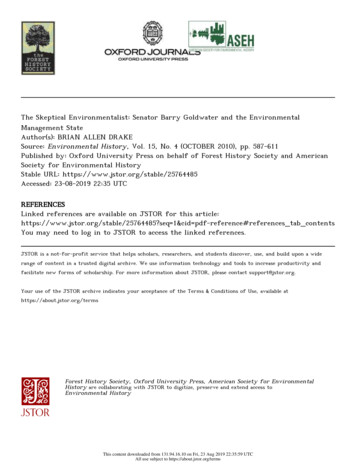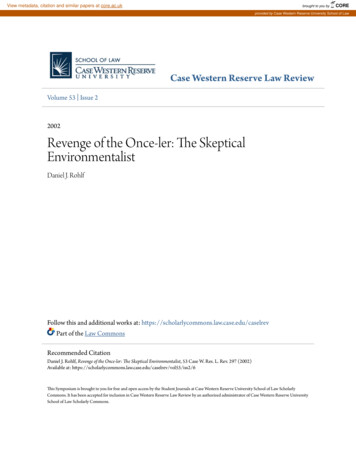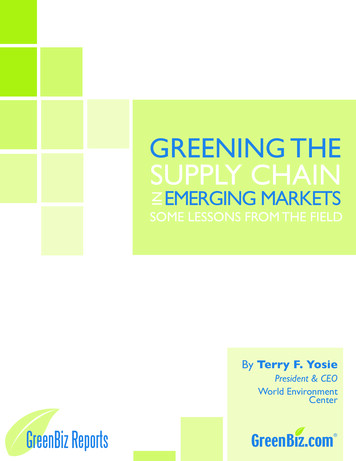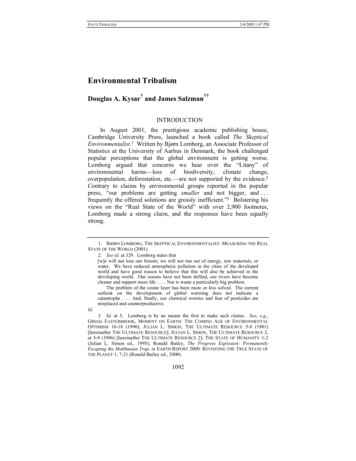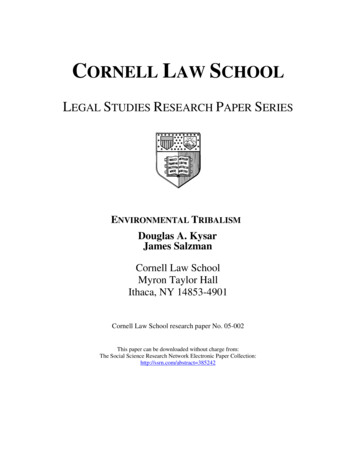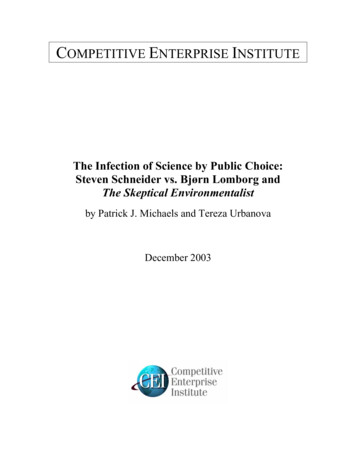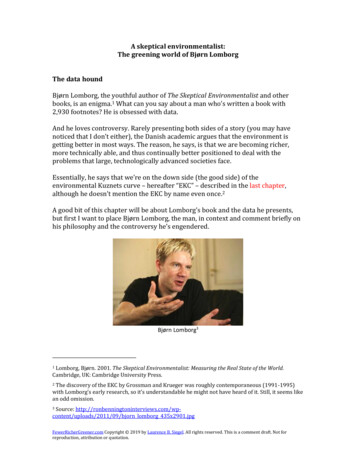
Transcription
A skeptical environmentalist:The greening world of Bjørn LomborgThe data houndBjørn Lomborg, the youthful author of The Skeptical Environmentalist and otherbooks, is an enigma.1 What can you say about a man who’s written a book with2,930 footnotes? He is obsessed with data.And he loves controversy. Rarely presenting both sides of a story (you may havenoticed that I don’t either), the Danish academic argues that the environment isgetting better in most ways. The reason, he says, is that we are becoming richer,more technically able, and thus continually better positioned to deal with theproblems that large, technologically advanced societies face.Essentially, he says that we’re on the down side (the good side) of theenvironmental Kuznets curve – hereafter “EKC” – described in the last chapter,although he doesn’t mention the EKC by name even once.2A good bit of this chapter will be about Lomborg’s book and the data he presents,but first I want to place Bjørn Lomborg, the man, in context and comment briefly onhis philosophy and the controversy he’s engendered.Bjørn Lomborg3Lomborg, Bjørn. 2001. The Skeptical Environmentalist: Measuring the Real State of the World.Cambridge, UK: Cambridge University Press.1The discovery of the EKC by Grossman and Krueger was roughly contemporaneous (1991-1995)with Lomborg’s early research, so it’s understandable he might not have heard of it. Still, it seems likean odd omission.2Source: ds/2011/09/bjorn lomborg 435x2901.jpg3FewerRicherGreener.com Copyright 2019 by Laurence B. Siegel. All rights reserved. This is a comment draft. Not forreproduction, attribution or quotation.
Challenging received wisdomOriginally a left-leaning Greenpeace member and “vegan backpacker,” Lomborg,while researching environmental science, was influenced by Julian Simon’s progrowth book, The Ultimate Resource (see chapter x, Simon and Ehrlich). Lomborgwrites,It all started in 1997, when [I] read a Wired Magazine interview witheconomist Julian Simon claiming that the environment - contrary tocommon understanding - was getting better, not worse. [T]his hadto be incorrect (“right wing, American propaganda”) I’m glad he wasn’t satisfied with his first reaction! Lomborg continues,[I] organized a study group with some of [my] top students to proveSimon wrong. [T]o everyone's surprise, much (though definitely noteverything) of what Simon said was right. [The project] led to thepublication of a Danish book later that year and to The SkepticalEnvironmentalist in 2001.4The critics howled The Skeptical Environmentalist touched off a firestorm of criticism, resembling inemotional temperature the response to the Ninety-Five Theses that Martin Luthernailed to the Wittenberg church door in 1517. Lomborg’s detractors fall into twocategories. One group claims that he is a climate change “denier” and an antienvironmentalist.5 He is nothing of the sort. “He has never denied that mankind’sactions are making the earth hotter, merely that it makes more economic sense toadapt to higher temperatures than resist them,” writes Matthew Moore in TheTelegraph.6 In his later work, Lomborg has become even clearer regarding his beliefin the science of global warming and his view that climate change constitutes ameaningful risk.But, pursuing economic reasoning, Lomborg wants to get good value per social orenvironmental dollar spent. He asks us to recognize that there are other problems4https://www.lomborg.com/for-journalistsI don’t like the word “denier” because it comes from “Holocaust denier,” a disgusting species ofperson who claims that the six million murdered European Jews never existed, mysteriouslydisappeared, or are still living. Expressing concern that climate change risk may be overstated, orthat the evidence for it is incomplete, or that money is better spent fighting other threats, is not in thesame category and people who make the connection should be ashamed of themselves.5Moore, Matthew. 2010. “Climate 'sceptic' Bjørn Lomborg now believes global warming is one ofworld's greatest threats.” The Telegraph (August -greatest-threats.html62FewerRicherGreener.com Copyright 2019 by Laurence B. Siegel. All rights reserved. This is a comment draft. Not forreproduction, attribution or quotation.
that need to be solved with the resources available, which are always limited. Eachproblem needs to be balanced against every other, with regard to both importanceand the likelihood that the proposed remedies will work. Lomborg’s CopenhagenConsensus Center supports programs relating to education, health, hunger,inequality, population growth, and trade and migration as well as specific countriessuch as India, Bangladesh, and Haiti. These are not the priorities of someone whodoesn’t care.The second category of critiques is that Lomborg is trained as a political scientistand statistician, not an economist or environmental biologist. He thus writes outsidehis field of expertise, does so with brio and confidence, and sometimes glosses overevidence contrary to the point he is trying to prove. Since I am doing the same thing(not sure about the brio), I’m going to ignore that critique.Comparing costs and benefitsLomborg gets one thing exactly right: all decisions, including environmental,personal, and political choices and any other kind of decision you might be facedwith, can only be made sensibly if you apply cost-benefit analysis. All of the costs,including hidden ones, must be fully accounted for, and long-run costs (or benefits)must be balanced against short-run benefits (or costs).In the same spirit, all of the benefits, including those you can’t see and that mayseem completely unrelated, must be accounted for. The long-run versus short-runbalance that matters for costs also matters for benefits.This principle of economics, or of life if you’ll permit me, goes back to FrédéricBastiat, the Frenchman from two centuries ago whom we met in chapter x, Scrooge.Bastiat did not even claim originality – he acknowledged his debt to the earlierhistorian François-René de Chateaubriand – so the idea is old indeed. Americansmay be more familiar with the brilliant restatement of Bastiat’s ideas by thejournalist Henry Hazlitt,7 or with their expression by Milton Friedman in hisbestselling books and public television shows.But, wherever you heard the idea, it is probably the most important economicconcept you’ll ever learn. Only “people respond to incentives” comes close.Hazlitt stated the rule in three parts: “The bad economist sees only what immediately strikes theeye; the good economist also looks beyond. The bad economist sees only the direct consequences of aproposed course; the good economist looks also at the longer and indirect consequences. The badeconomist sees only what the effect of a given policy has been or will be on one particular group; thegood economist inquires also what the effect of the policy will be on all groups.” Hazlitt, Henry. 1946.Economics in One Lesson. New York: Harper & Brothers.73FewerRicherGreener.com Copyright 2019 by Laurence B. Siegel. All rights reserved. This is a comment draft. Not forreproduction, attribution or quotation.
Prioritizing ways of helping the worldEven if only half of what Lomborg says is true, then, most of us are thinking aboutenvironmental remediation in the wrong way. There are only so many resources inthe world, and only a fraction of them are available to be spent on social,environmental, health, and allied problems. That fraction could and should rise orfall according to need; but whatever amount is available, it should be spent asefficiently as possible. It should be spent in a way that reflects not just the severityof each problem but “how effective our solutions might be.”Lomborg’s 2004 Copenhagen Consensus (a convention of experts) came to thesurprising conclusion that adding micronutrients to the diets of the poor, andcontrolling HIV and AIDS, offered the biggest “bang for the buck,” and climatechange mitigation the smallest.8 That is not because climate change is unimportant;although Lomborg had argued that past warming had mostly been beneficial, hebelieves warming could be very harmful in the future. It’s because, according to hispanel of experts, the proposed remedies are likely to have astronomical costs andwill do almost nothing to solve the problem.But what kind of experts did Lomborg think it was wise to assemble? Prioritizing theproblems and solutions, given their various potential costs and benefits, is the taskat hand. And, since figuring out how to allocate limited resources to satisfyunlimited needs is what economists do, Lomborg assembled his brain trust fromamong the community of economists. Not biologists or sociologists or doctors;economists. This approach provides a fresh set of eyes with which to view theproblem and is to be commended.Later versions of the Consensus have given more favorable play to climate changeremediation. However, it still ranks far below a number of lower-cost, higher-impactprojects such expanding access to contraception, making it easier for workers tomigrate in search of opportunity, and promoting free trade among nations.Some of the experts in his group rebelled. The late Thomas Schelling, who won the2005 Nobel Prize in economics, thought that if a more modest proposal to combatclimate change had been considered, it would have ranked higher; the remedyunder discussion was too radical. Jeffrey Sachs, head of the Earth Institute, objectedthat economists were the wrong kind of experts to make such choices, but Lomborgcountered that “that was the very point of the project. Economists have expertise ineconomic prioritization. It is they and not climatologists or malaria experts who canprioritize between battling global warming or communicable disease.”98https://www.ted.com/speakers/bjorn lomborgLomborg, Bjørn. 2004. “Need for economists to set global priorities.” Correspondence, Nature,volume 431, page 17 (September 2).94FewerRicherGreener.com Copyright 2019 by Laurence B. Siegel. All rights reserved. This is a comment draft. Not forreproduction, attribution or quotation.
Economic growth über alles?Lomborg’s philosophy meshes, to some degree, with the New York Times sciencereporter John Tierney’s famous claim that “the richer everyone gets, the greener theplanet will be in the long run.”10 Getting richer not only feeds, heals, and educatespeople, and gets rid of smoke and sulfur dioxide as we saw earlier, but helps withdecarbonization and ultimately reduces warming trends. Tierney explains: [A]s people get wealthier they can [not just] afford cleaner waterand air., [t]hey start using sources of energy that are less carbonintensive — and not just because they’re worried about globalwarming. The process of “decarbonization” started long before AlGore was born.As their wealth grows, people consume more energy, but theymove to more efficient and cleaner sources — from wood to coal andoil, and then to natural gas and nuclear power, progressively emittingless carbon per unit of energy. This global decarbonization trend hasbeen proceeding at a remarkably steady rate since 1850, according toJesse Ausubel of Rockefeller University and Paul Waggoner of theConnecticut Agricultural Experiment Station.(We’ll return to carbon emissions later in this chapter, when we showvarious attempts to quantify the EKC.)An urban, high-tech society is very energy-efficient and will gradually becomealmost carbon-free, says Tierney:“Once you have lots of high-rises filled with computers operating allthe time, the energy delivered has to be very clean and compact,”said Mr. Ausubel, the director of the Program for the HumanEnvironment at Rockefeller. “The long-term trend is toward naturalgas and nuclear power, or conceivably solar power. If the energysystem is left to its own devices, most of the carbon will be out of it by2060 or 2070.”These are bold claims, and they amount to more than an assertion that the EKCexists. It is an argument that, followed to its logical extreme, suggests you don’t wantto do anything to save the environment until we all become “rich” because it will beso much easier to do it then. All surplus resources should be reinvested in economicgrowth, not environmental remediation – at least that’s where this thinking couldlead you.Tierney, John. 2009. “Use Energy, Get Rich, and Save the Planet.” New York Times (April th/21tier.html. My italics in the block quote.105FewerRicherGreener.com Copyright 2019 by Laurence B. Siegel. All rights reserved. This is a comment draft. Not forreproduction, attribution or quotation.
Rich is in quotes because, in this setting, it does not mean Lifestyles of the Rich andFamous, mansions and yachts. We are rich when everyone in the world has theopportunity to enjoy a decent, modern, well-fed, well-housed, well-educatedlifestyle.Tierney’s logic implies that, when we reach that goal, not just through capital andskills accumulation but through technological advances that may have the side effectof making environmental improvements easy and cheap, only then should we makethe environment our primary focus. Until then, it’s about people, betterment,enrichment.I’m exaggerating for effect, of course. Bjørn Lomborg wouldn’t accept the mostextreme implications of this logic, and he celebrates the environmentalimprovements we’ve made in the past. He would say they were absolutely necessaryand also not good enough. It’s a little unfair to link Lomborg’s eclectic utilitarianismwith Tierney’s “hard green,”11 and I’m not sure Tierney accepts the full import of hisown logic either (I don’t know his work intimately) – but both men make validpoints and enjoy making mainstream environmental thinkers uncomfortable.As with most issues, I favor moderation, a concerted but not radical effort to achieveenvironmental improvements in the here and now while growing the globaleconomy to a point where we may not all be rich, but all people have a better thanfighting chance to achieve what we would now call a middle-class existence.Evidence of a greening world: “Good but not good enough”Lomborg begins The Skeptical Environmentalist with what he called “the Litany,” theusual recitation of ways in which the growing population and its increasing wealthare supposedly ruining the environment. Of course, there’s a grain of truth to theLitany – as we saw in the previous chapter, early stages of agricultural andindustrial development can be ecologically terrible.Lomborg then demolishes most of the Litany, but since we’ve already heard thatfrom Ridley, Rosling, Norberg, and Pinker,12 we’ll skip that part, except to point outthe Lomborg finds a few rotten apples in the horn of plenty. For example, as of 2010,680 million people in the developing world, some 9% of the world population, werestarving. Not malnourished – starving, the technical definition of which is havingHere, I use “hard green” as the author Peter Huber [1999] did, to mean not radicalenvironmentalism but the old-school conservationism of Teddy Roosevelt. I’ve deliberately avoidedciting the work of Huber, a senior fellow at the Manhattan Institute and a Forbes columnist; his greenis a little too hard for me. Huber, Peter W. 1999. Hard Green: Saving the Environment from theEnvironmentalists, A Conservative Manifesto. New York: Basic Books.1112Lots of Scandinavians!6FewerRicherGreener.com Copyright 2019 by Laurence B. Siegel. All rights reserved. This is a comment draft. Not forreproduction, attribution or quotation.
“inadequate [food] to cover even minimum needs for a sedentary lifestyle.”13 Whileit’s a big improvement from the recent past when many more people were starving,it’s definitely “not good enough.”In the next sections of The Skeptical Environmentalist, Lomborg then demonstratesimprovement in population control, life expectancy, health, nutrition, moneyincomes, consumer goods (a Lomborg graphic appears in chapter x, technology andjobs), education, leisure, and safety – concepts familiar from our earlier chapters. Hethen responds, mostly optimistically, to a number of concerns about depletingresources, such as forests, fisheries, energy, minerals, and water. (Water? Really?We have enough water?) This line of reasoning is not new, although Lomborgimpressively squeezes it all, with mountains of supporting data, into a singlevolume.Lomborg is not a Pollyanna. He says that many things about our world are good butnot good enough. His Copenhagen Consensus organization has evolved from onemainly concerned with conserving the environment in an economically efficient wayto a broader-based problem-solving group. The group now seeks out expert opinionin finding a balance between environmental issues, nutrition, health, social welfare,liberty, and many other questions.Cough, coughThe part of The Skeptical Environmentalist that links most closely to the EKCdiscussed in the last chapter starts with Lomborg’s chapter entitled “Pollution.”Pollution is what we first think of when we contemplate environmental destruction,although it is obviously not the only serious concern.Exhibit 1 shows the evolution of sulfur dioxide and smoke pollution in London overa very long period of time, from Shakespeare’s day through the present.Exhibit 1Sulfur dioxide and smoke concentration in London, 1585-2000Definition used by the United Nations Food and Agricultural Organization, cited in Hickel, Jason.2015. “The hunger numbers: are we counting right?” The Guardian (July rs-are-we-counting-right. This definition gives a low estimate of the incidence ofhunger because most poor people cannot survive while engaging in a sedentary lifestyle; they moretypically need to perform heavy physical labor involving much higher caloric consumption.137FewerRicherGreener.com Copyright 2019 by Laurence B. Siegel. All rights reserved. This is a comment draft. Not forreproduction, attribution or quotation.
Source: Lomborg [2001], p. 165.Strictly speaking, this isn’t an EKC because it plots pollution against time, not wealth,but London got richer so steadily over the period that pollution might as well beplotted against wealth in this diagram. Clean, dirty (peak dirty in the mid- to late1800s), clean.How do we know how much sulfur dioxide or smoke was in the air in London in1585? We don’t, exactly. According to Lomborg,On the basis of coal imports the British environmental scientist PeterBrimblecombe has estimated the concentrations of sulfur dioxideand smoke (particles or soot) in the air from as far back as 1585 [L]evels of smoke pollution increased dramatically [for] 300years only to have dropped even faster [starting in] the latenineteenth century such that the levels of the 1980-1990s are belowthe levels of the late sixteenth century.This despite the fact that last severe London smog, which occurred in 1952,“killed about 4,000 Londoners in just seven days,” some by drowning afterhaving fallen into the Thames because they could not see it.Lomborg continues,[S]moke or particles are probably by far the most dangerouspollutant. In other words, with respect to the worst pollutant theLondon air has not been as clear as it is today since the Middle Ages Air pollution is not a new phenomenon that has gotten worse and8FewerRicherGreener.com Copyright 2019 by Laurence B. Siegel. All rights reserved. This is a comment draft. Not forreproduction, attribution or quotation.
worse – it is an old phenomenon, that has been getting better andbetter [for over a hundred years].14Incomes and pollutionGene Grossman and Alan Krueger, the discoverers of the EKC, whom we met in theprevious chapter, hypothesized and then documented a relationship betweenincome and environmental quality. We haven’t quite demonstrated this, exceptindirectly in the case of London smog. But Lomborg’s research turns up a directconnection.Exhibit 2 shows the relation between country income (that is, PPP-adjusted percapita GDP) and particulate-matter air pollution in 1972 and 1986. In both years,pollution turned down as incomes rose above about 3000 per year – about 7000in today’s money, or about the income level of India or Guatemala.15Exhibit 2Environmental Kuznets curves: The relation between PPP GDP per capita andparticulate-matter air pollution in 48 cities in 31 countries in 1972 and 1986Source: TSE, p. 177.Lomborg (2001). Op. cit, p. 164. London’s population also grew tremendously over the period, so ifthe x-axis represented per capita real income, not the total real income that is roughly captured bythe time dimension, the pollution curve would have peaked earlier and come down more quickly.14Although the data in Lomborg’s example are old and the specific problems represented by theexample have largely been solved, the underlying principle is still valid and important.159FewerRicherGreener.com Copyright 2019 by Laurence B. Siegel. All rights reserved. This is a comment draft. Not forreproduction, attribution or quotation.
But the amount of pollution at the peak of the curve also fell by about 25% between1972 and 1986; not only does each curve slope downward beyond a certain level ofincome, the curve itself moves lower over time, representing less pollution at eachincome level as time passes. A similar analysis of sulfur dioxide shows peakpollution at about the same income level, but with a steeper lowering of the curveover time – 60% between 1972 and 1986.Is the environmental Kuznets curve a universal principle?Will this upside-down U-shaped relation between incomes and pollutants alwayswork? Probably not. Some pollutants continue to rise with incomes, although truebelievers in the curve would say that incomes are just not high enough yet for theamount of pollutant to turn down. (This appeared to be the case with carbon untilrecently; more on that later.) And some pollutants fall with incomes at all levels,never showing a rising part of the curve.There are some exceptions to the EKC. Species diversity is a particularly difficultone. As income levels rise, you don’t get new species to replace those that havebecome extinct. This is because, no matter how clean the environment, new speciestake a long time to “appear” (that is, to become differentiated from existing ones).16Yet, if you go beyond the species to the individual animal as the unit of analysis, thecurve comes back. “The Kuznets curve,” writes the British researcher Alexander C. R.Hammond,not only applies to forest area [which is increasing in rich countries;see chapter n, Cities], but also biodiversity. [Matt] Ridley gives theexample of three apex predators: wolves that live in developedcountries of Europe and North America, tigers who mainly inhabitmid-income India, Russia and Bangladesh, and lions, which live inpoor Sub-Saharan Africa. Following the Kuznets curve, wolves arerapidly increasing, tiger numbers have been steady for the last 20years (and have just began to increase), while lion numbers continueto fall.17Lomborg is sanguine about whether the general EKC principle can be relied onacross time and differing circumstances: “There are no decisive reasons to assumethat the same development will not happen in the Third World which today facesAt least this is true of large, familiar animal and plant species. Bacteria and other microorganismscan evolve faster than we destroy them. What most people call “biodiversity” refers to animals andplants, which are a small fraction of the living things on earth.16Hammond, Alexander C. R. 2018. “No, We Are Not Running Out of Forests.” humanprogress.org(online, May 24), https://humanprogress.org/article.php?p 12951710FewerRicherGreener.com Copyright 2019 by Laurence B. Siegel. All rights reserved. This is a comment draft. Not forreproduction, attribution or quotation.
serious environmental problems equivalent to those we faced 50 [to] 80 yearsago.”18Different curves for different problemsIn other work (not covered by Lomborg), the EKC is shown to move around a lotdepending on what pollutant or index of environmental quality you care about. Thepeak is not always at 7000. Alexander C. R. Hammond writes, “Once nations hitaround 4,500 GDP per capita, forest areas begin to increase.”19 That’s a pretty lowincome, below that of Pakistan and close to that of Bangladesh.But, for some materials, the point at which the EKC turns down is much, muchhigher – and therein lies the rub. The remarkable energy density of fossil fuelsmakes their use very desirable if one ignores environmental considerations. For thisreason, carbon emissions are among the last to decrease as incomes rise; fossil fuelconsumption is a type of luxury good.Here is an estimate (not from Lomborg) of the EKC for carbon, separated intoemissions from production and emissions from consumption:Exhibit 3Production- and consumption-based environmental Kuznets curves (the heavier linerepresents consumption)Source: Aldy [2004].2018Lomborg (2001), ,p. 176.19Hammond. 2018. Op. cit.Aldy, Joseph E. 2004. “An Environmental Kuznets Curve Analysis of U.S. State-Level Carbon DioxideEmissions.” Department of Economics, Harvard University (August 9),2011FewerRicherGreener.com Copyright 2019 by Laurence B. Siegel. All rights reserved. This is a comment draft. Not forreproduction, attribution or quotation.
Note: The figure presents the fitted values for the 1,920 income-per-capita observationsin the data. To convert to current (2018) dollars, multiply the 1999 dollar amounts by1.51.Note that the two curves have very different shapes. The higher one (showing lessimprovement) is for carbon emissions from consumption. The lower one (showing abigger reduction in emissions) is for production.21 For example, the carbon footprintof manufacturing, say, a washing machine (production) is much lower at higherincomes, while that of operating that same machine (consumption) does notimprove as much.Peak carbon emissions, then, seem to be around the income levels of the world’snewly industrialized or moderately rich countries. Rich-country CO2 emissions arebeginning to turn down sharply, as Western European, U.S., and Japanese incomespass through the 40,000- 60,000 range. The change is due to several factors: moreefficient vehicles and power plants, the growth of alternative energy sources, andsocial developments such as less driving. These trends bode well for the long-termfuture of the Earth, when today’s middle-income countries are rich and today’s poorcountries are middle-income – if we can get there in one piece.By the way, the EKC doesn’t work “all by itself.” Public policy is instrumental inlimiting pollution or emissions of any kind, for the reason stated earlier: privateparties always try to externalize. The reason a country with a per capita GDP higherthan, say, 7000 begins to reduce particulate-matter air pollution is that the people,expressing their will through the political system, are at that point able and willingto make the sacrifice necessary to reduce pollution. The same principle works withcarbon, at a different income level. That is one reason why we should encourage asmuch economic development as possible.Conclusion: Some ways to spend a trillion dollarsLomborg’s economic-efficiency approach to thinking about the environment leadsme to propose a thought experiment. Suppose a trillion-dollar expenditure, now,devoted to decarbonizing the global energy supply, would (with certainty) lead to a0.5 C. (about one degree Fahrenheit) decrease in the global average temperature in2100, relative to what it otherwise would be.It is very unlikely to do anything of the kind: the fully allocated cost, including lossesin transportation efficiency and so forth, would be many times larger. But let’s sayfor the sake of argument that the strategy will work.https://sites.hks.harvard.edu/m-rcbg/repsol ypfksg f.Aldy calls the two kinds of activities “pre-trade” and “post-trade.” I have reinterpreted these termsas production and consumption.2112FewerRicherGreener.com Copyright 2019 by Laurence B. Siegel. All rights reserved. This is a comment draft. Not forreproduction, attribution or quotation.
Assuming that the point of spending the trillion in the first place is to help people,what else could we do with the money? If, as I said earlier in this chapter, 680million people are starving, we could buy each of them 1,470 bowls of golden rice ata dollar a piece – now that would make a difference! We would almost certainly beable to eradicate malaria – about ten times over, according to the Gates Foundation.That would make hundreds of millions of tropical residents dramatically moreproductive. They would feel much better too.A trillion dollars would more than suffice to build a seawall that would protectBangladesh from flooding due to rising sea levels for a millennium. With the leftovermoney, we could protect Venice, New Orleans, and (if you care) Miami Beach. Wecould educate a hundred million girls in Africa and the Middle East. The possibilitiesare endless unless you consider the trillion dollars to be spoken for by the One TrueCause.Of course, given enough time, we can come up with more than just one trilliondollars to spend. But resources are not unlimited and never will be. To paraphraseSenator Everett Dirksen, a trillion here and a trillion there and pretty soon you'retalking about real money. Trying to control the earth’s climate fluctuations byremoving the part of them that is manmade is one strategy, but trying to efficientlyadapt to the fluctuations – and helping people in a myriad of other wa
The Skeptical Environmentalist touched off a firestorm of criticism, resembling in emotional temperature the response to the Ninety-Five Theses that Martin Luther nailed to the Wittenberg church door in 1517. Lomborg's detractors fall into two categories. One group claims that he is a climate change "denier" and an anti-



